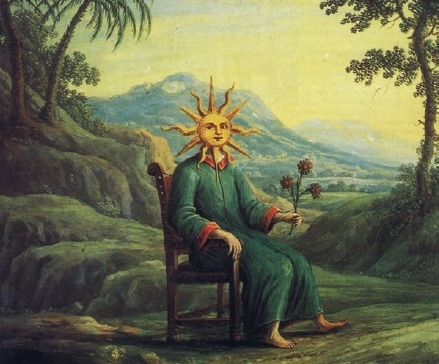
The alchemist who has achieved illumination.
It is known that alchemy originated from Hermeti(ci)sm. Some have even considered the two synonymous. We have also seen that Sufism is the contemporary form of Hermeticism. This suggests that there should be some affinity between Sufism and alchemy. In the present article, we focus on this subject.
The first famous Moslem alchemist, Jabir ibn Hayyan, was also considered a Sufi. And a famous Sufi, Dhun-Nun (or Dhul-Nun) al-Misri (9th century), from Akhmim/Panopolis, was also known as an alchemist. The alchemist Uthman ibn Suwaid, from the same town and time as Dhun-Nun, wrote a treatise defending the latter. Ibn Suwaid is known as the author of the Mus’haf al-Jama’a, the Arabic prototype of the alchemists’ famous Turba Philosophorum (“Assembly of Philosophers”). And the famed Moslem scholar Al-Ghazali (1058–1111) wrote the “The Alchemy of Happiness” (Kimiya-yi Sa’adat), dealing with Islamic philosophy and spiritual alchemy.
According to Titus Burckhardt, “It was in the Islamic world that alchemy reached its fullest flowering. Jabir ibn Hayyan, a pupil of the sixth Shiite Imam Jafar al-Sadiq, founded in the eighth century A.D. a whole school, from which hundreds of alchemical texts flowed forth. No doubt it was because the name Jabir had become the hallmark of much alchemical lore that the author of the Summa Perfectionis, a thirteenth-century Italian or Catalan, also assumed the name in its latinized form of Geber.” (Burckhardt, Alchemy (1971) [1960], p. 19.)
The origin of alchemy in Hermetism immediately disqualifies it from being solely an attempt to transmute physical lead into physical gold. Rather, at least in its origins, it had to do with spiritual transmutation. The alchemists used physical and chemical processes as allegories for psychic/spiritual processes, much as the present author has used processes known to modern physics for the same purpose from time to time. Only they did this in much more obscure ways. But would a spiritually transformed person not be able to change physical lead into physical gold? Two stories of the Master, one from the Sufi Mahmud Hudayi and the other from the Prophet’s cousin and Fourth Caliph Ali, are suggestive in this regard.

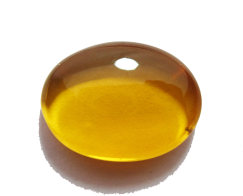
If stone touches hand
The hand is glad
If hand touches stone
The stone becomes amber
The hand is glad
If hand touches stone
The stone becomes amber
—Master Ahmet Kayhan
The epigraph above is a Sufi saying. The “hand” refers to the Sufi master or teacher. The “stone” refers to seeker, or more precisely, the seeker’s Base Self, which is as hard to transform as stone. If the master finds a true, earnest student, the master is pleased. And if the master works his spiritual blessings (baraka) on the student, the Base Self will be transformed into “amber,” or the Purified Self. The Sufi master able to do this is a Perfect Human (insan al-kâmil), who has the ability to transmute other human beings also into perfect humans.
Let us now switch metaphors, and read the same epigraph by substituting other words:
If lead touches the Stone
The Stone is glad
If the Stone touches lead
The lead becomes gold.
As can be seen, we are now in the domain of alchemy, where “the Stone” is the famous Philosophers’ Stone, capable of transmuting lead into gold. Yet the meaning remains the same. The first famous alchemist, Zosimos of Panopolis (c. 300 AD) as well as others, made it clear that the alchemical quest was primarily spiritual in nature.The Stone is glad
If the Stone touches lead
The lead becomes gold.
The final goal of the alchemical work (also called the “Great Work” or “Red Work”) is the Red Stone or Elixir (of Immortality), also called “drinkable gold.” This refers to the Philosophers’ Stone and its liquid form. (The color red represents energy and activity.)
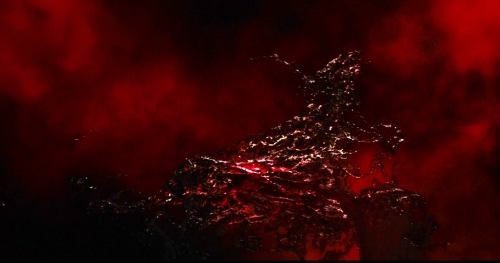
In the Marvel Cinematic Universe (MCU), there are six Infinity Stones (or Gems).
Thor: The Dark World (2013) revolves around the Aether, the Reality Stone.
It has the power to make all your wishes reality. Conversely, in the hands of a Dark Elf
(a personification of the Base Self), it can be used to zap every dimension into darkness.
It is an inky red cloud, and the only Stone that can be transformed into a liquid.
Thor: The Dark World (2013) revolves around the Aether, the Reality Stone.
It has the power to make all your wishes reality. Conversely, in the hands of a Dark Elf
(a personification of the Base Self), it can be used to zap every dimension into darkness.
It is an inky red cloud, and the only Stone that can be transformed into a liquid.
“[I]bn ‘Arabi regards gold as the symbol of the original and uncorrupted state (al-fitrah) of the soul, the form in which the human soul was created at the beginning. According to the Islamic conception, the soul of every child unconsciously approaches this Adamic state, before being led away from it again by the errors imposed on it by adults.” (Burckhardt, Alchemy, p. 126.) In a nutshell: every child is pure-born (no exceptions). In this view, which is based on a Prophetic Saying, Islam is humanity's natural state, and embracing it is a reversion to the default mode.
We shall attempt to show the affinities between alchemy and Sufism by recourse to alchemistic imagery. We begin with pictures or “emblems” that most closely parallel Sufic concepts.
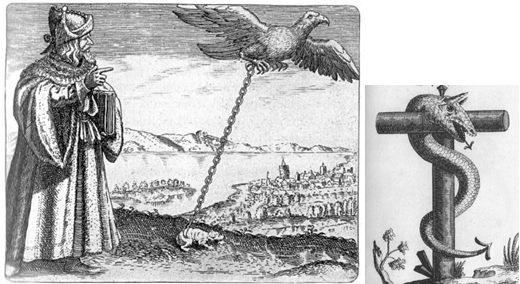
In the picture at left, the totality of a human being is indicated by three separate entities: a man (the body), a toad (the self, or—as the alchemists called it—the soul), and an eagle (the spirit). (Or—according to Paracelsus—Salt is body, Sulphur is soul, Mercury is spirit.) More specifically, the toad, which is considered to be ugly, is a symbol for the Base Self, the ordinary, untrained level of selfhood. This is also the nigredo (black) state of fallen existence. It is akin to Nietzsche’s “spirit of gravity,” through whom “all things fall,” and which he referred to as “my devil.” The eagle is chained to the toad, and cannot soar high, despite its (the spirit’s) natural tendency to do so. For the spirit to fly, the toad has to be transformed into, well, a prince: it has to be imbued with exemplary, Godly ethics. That is the meaning of the Purified (or Perfected) Self.
The snake is another symbol for the Base Self. It should be “crucified”—that is, subjected to a process of purification that will drive the snake-ness out of it.
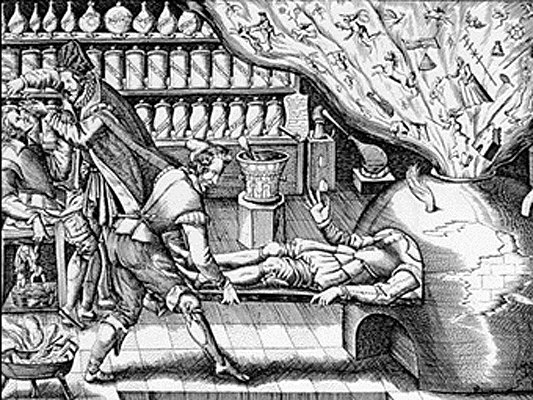
The Sufi seeker must rid him-/herself of “everything-other-than-God” (ma siwa Allah). This is facilitated by the hardships of life, and sometimes the student is tested by the master himself. The preceding alchemical picture is a very clear depiction of this. The oven or fire (external heat) stands for the hardships that drive all things out of the mind, leaving a space behind for accomodating God.
The Fifth Element
The alchemists adhered to the view that the world was made up of the four classical elements: air, fire, water, and earth. In addition, they conceived of a prime/primal/primordial matter out of which the four elements had become differentiated: the Fifth Element (quintessence). This First Matter the Greeks called hylê and the Sufis, hayûlâ. Aristotle’s fifth element was the Aether, which he conceived of as a heavenly substance. Medieval alchemists thought it had medicinal and curative properties. Over time, the fifth element became identified with the Elixir and the Philosophers’ Stone itself.
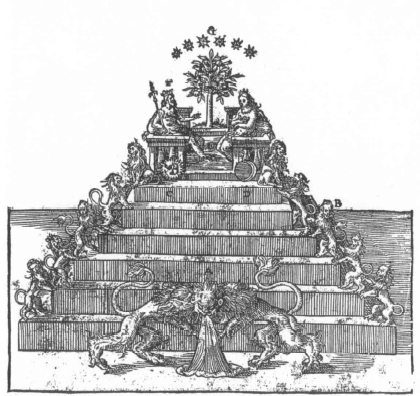
I died from the mineral, and plant became
Died from the plant, and took an animal frame;
Died from the animal, and donned a human dress
When by my dying did I ever grow less?
Died from the plant, and took an animal frame;
Died from the animal, and donned a human dress
When by my dying did I ever grow less?
Thus the famous Turkish Sufi poet Rumi. (Note that this does not refer to reincarnation, but to the “arc of ascent” of Becoming.) Similarly, Sufis envisage a personality transformation through seven levels of selfhood. At each transition, the present stage of self is dissolved and the next stage “gels.” Likewise, the picture above shows seven dissolutions and seven coagulations.
Most alchemical pictures contain the sun and moon, male and female (or sulphur and mercury) together as a “conjunction of opposites,” called jam’ al-azdad in Sufism. Only when opposites are reconciled and integrated can the Multiplicity (kasrah) of this world fall away, revealing Unity (wahdah). Ouroboros
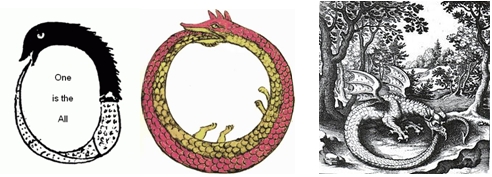
The leftmost figure is one of the earliest depictions of the Ouroboros, from the Chrysopoeia (“Gold-making”) of Cleopatra the Alchemist (3rd-4th century AD). Translation of the Greek text has been inserted. A 4th-century Greek alchemist, Synesios, said: “Everything comes from One and returns to One,” which is close to “We come from God and we shall return to Him” (the Koran, 2:156).
The Ouroboros is the serpent (or dragon) that eats its tail, for alchemists a symbol of the One, of infinity, eternity, and wholeness. According to psychologist Carl G. Jung, famous (among other things) for his studies of alchemy, “The Ouroboros is a dramatic symbol for the integration and assimilation of the opposite, i.e. of the shadow.” As on other occasions with the shadow, Jung is again correctly approximating the Base Self of the Sufis. The famed alchemist Michael Maier comments:
The Dragon bites its tail and swallows it,
Taking for food a great part of itself.
Subdue it by hunger, prison, iron, until
It eats itself, vomits, dies, and is [re]born.
Taking for food a great part of itself.
Subdue it by hunger, prison, iron, until
It eats itself, vomits, dies, and is [re]born.
(Atalanta Fugiens (1617), Epigram 14, trans. Joscelyn Godwin.)
Here, Maier is treating the dragon exactly as the Base Self. One must tame and train the Base Self if it is to yield the Purified Self. Hunger is a basic component of Sufi asceticism. Drastic measures, however, are unnecessary, either against the Base Self or the body. For the Master stated that abstention from Illicit Gain and Illicit Sex is enough to imprison the Base Self. One should beware of going to extremes in asceticism, as indeed in all things: “Who goes to extremes, is ruined” (the Prophet). To “slay the dragon” is to close these two doors of unclean sex and gain. If the human body or vessel is thus “hermetically sealed” against Prohibited influences, it will be possible to ferment the Child in the retort.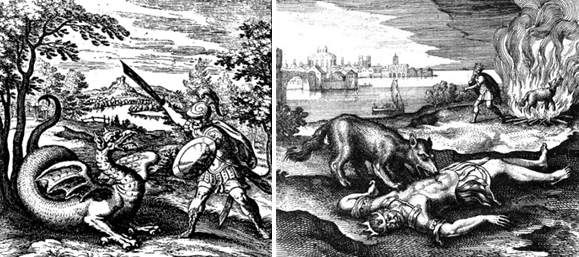
Sometimes, instead of a dragon swallowing its tail, we see two dragons swallowing each other’s tails. One of these may be portrayed with wings. This is the famous “arc of descent” versus “arc of ascent” of the Sufis, which I have already dealt with in “Hermeticism and Sufism.”
Another symbol for the Base Self is a ravenous wolf. In one of Maier’s engravings, a wolf devours a king, but the king is liberated when the wolf is set on fire. The text of the First Key of Basil Valentine, which is essentially the same as Maier’s, says: “Cast to him the body of the King, and when he has devoured it, burn him entirely in a great fire. By this process the King will be liberated.” This is similar to the phoenix that is reborn from its ashes, and is a symbol for spiritual death/rebirth. In Sufism, the king here would stand for the Perfected Self, which is vanquished by the Base Self. But when the Base Self is purified, it reverts to the Perfected Self. In physical terms, the wolf represents antimony sulfide (stibnite), which in molten form “voraciously” removes impurities from melted gold (the king).
While on this subject, it needs to be mentioned that the dream of some alchemists to obtain gold from other metals solely by chemical reactions was nothing but a pipe-dream. Nuclear physics has demonstrated conclusively that the transmutation of elements occurs only at the level of atomic nuclei. Tin (Atomic Number: 50) plus copper (AN: 29) yield gold (79). But the nuclei of the first have to be accelerated to ten percent the speed of light before striking the nuclei of the second if repulsion is to be overcome and fusion to occur. (It is also possible, but again extremely difficult, to obtain gold by nuclear fission.)
The King
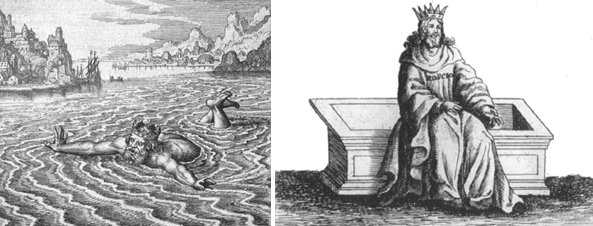
The King swims in the sea, crying with a loud voice:
“He who rescues me shall have a mighty reward!”
“He who rescues me shall have a mighty reward!”
The King, whose crown is heavy on his head,
Swims in the wide sea and cries aloud:
“Why don't you rescue me? Rush forward, all,
You whom I can make happy when I'm saved!
If you are wise, then take me to my realm,
And poverty and sickness you'll forget.”
Swims in the wide sea and cries aloud:
“Why don't you rescue me? Rush forward, all,
You whom I can make happy when I'm saved!
If you are wise, then take me to my realm,
And poverty and sickness you'll forget.”
(Atalanta Fugiens (1617), Epigram 31, trans. Joscelyn Godwin.)
In this case, the king represents the Perfect Master. The sea is the bottomless ocean of Unity (wahdah)—an “ocean without a shore.” But the Master stays in shallow waters in order to remain accessible to others. Taking the king to his realm is to accompany him to the Ocean of Unity.It is not the king who will be saved—it is us. God wants us, desires us, loves us, and wishes that we love Him, too. To recall a saying of the Master: “A Sacred Saying: ‘I did not fit in anyone’s Heart but the Heart of the Perfect Faithful.’ Nobody says ‘Don’t do it,’ He says, ‘Work and become,’ for heaven’s sake!”
He also said: “They catch fish in the middle of the great sea. It’s been sixty years, they couldn’t catch a big man [i.e. the Master himself]. This answer is enough for everybody.”
Another picture of a king depicts him being resurrected from a coffin. The coffin symbolizes spiritual death/rebirth, in accordance with the Saying of the Prophet: “Die before you die.” One who undergoes this transformation is born again as a “spiritual king,” a Perfect Master, and possesses the keys to the Kingdom. As Alexander Roob comments, he now “has the power to turn all the servants into kings”—that is, to enlighten disciples. (Roob, Alchemy and Mysticism (2001), p. 220.) Not only can he take human beings and make them as good as gold, but he can also transform them into Philosophers' Stones, like himself.
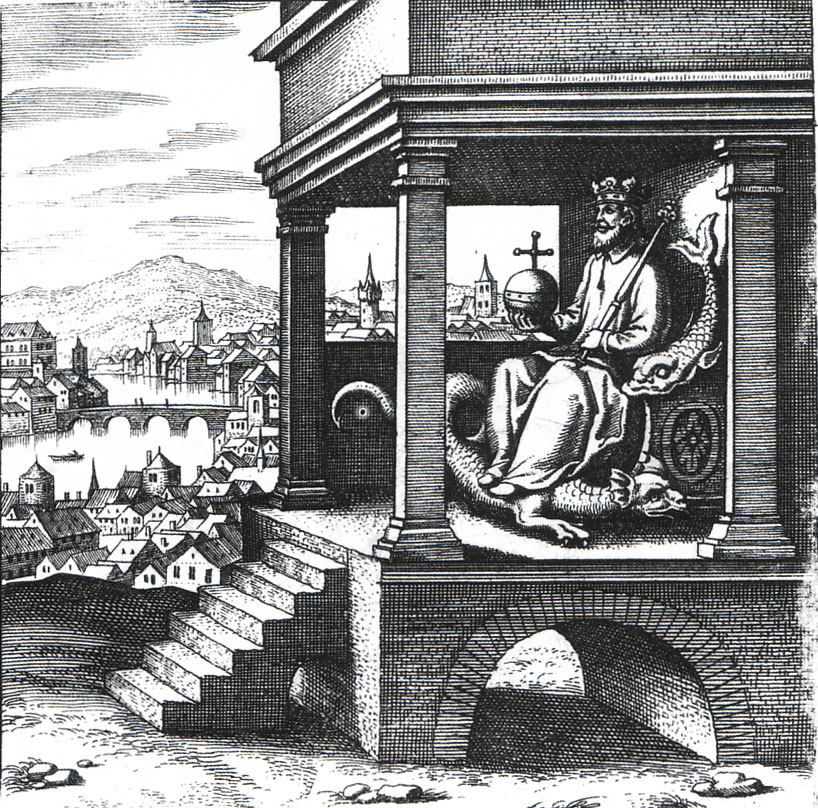
Alchemical Terms
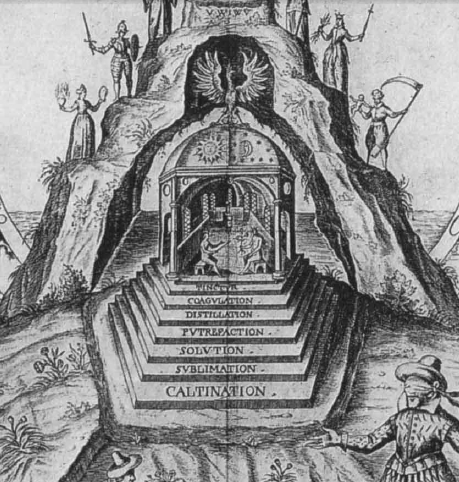
In this picture, the mountain represents the human being. Seven steps, corresponding to the seven stages of the self in Sufism, lead up to the level of Attainment (wuslat). The phoenix at the top represents the final spiritual death/rebirth. Each stage of self-purification may actually involve one or more of these “steps.”
Some of the names of alchemical stages or processes are highly suggestive of Sufic concepts. The Sufic correlates of some of these terms are given below: Calcination: This is a thermal treatment that brings about decomposition of materials. Likewise, the Base Self has to be broken down through hardships so that it can advance to higher stages of selfhood.
Dissolution: The Base Self has to be dissolved completely to make way for the final stage of the Purified Self.
Separation: The corresponding Sufic term is farq (differentiation), where the Sufi is in a state of “dispersion” or separation from God. In a more general sense, it denotes the distancing of oneself from unclean things and sins so that spiritual transmutation may become possible.
Conjunction: The corresponding Sufic term is jam‘, which I have elsewhere translated as “fusion.” It has also been called “all-comprehensiveness” and “undifferentiation.”
Fermentation: A process that results in greater receptivity of the self to higher influences.
Distillation: Purification, called “purification of the self” (tazkiyah al-nafs) in Sufism. This may refer to the entire process from beginning to end, or to a certain part of it.
Coagulation: Also called congelation. Similar to metamorphosis, where a mature butterfly “congeals” within a chrysalis. As an earlier stage of selfhood is dissolved, a subsequent stage of the self coagulates or “crystallizes.”
Cohobation: The process of repeated distillation of the same matter. In our times zone melting is a similar, repetitive process of purification. So is uranium enrichment. This is what the Five Daily Prayers are for: a great many repeated purifications finally enable the self to become a proper receptacle for the divine.
Ceration: Softening a hard substance, namely the “rock” that is the Base Self.
Sublimation: The “ascension of the individual soul to the Infinite” (Burckhardt, p. 166), to the Essence of God (az-Zât), which is the “Azoth” of Paracelsus. (Idries Shah, The Sufis (London: Octagon Press, 1977) [1964], p. 204.)
This was the universal medicine or universal solvent, also called the alkahest, the vision and goal of the alchemists. The self becomes dissolved or extinct (fana) in God. The term alkahest is likewise attributed to Paracelsus and considered to be pseudo-Arabic, but if he had heard of the Persian Sufi term tarq-i hastî (abandonment of one's being or self), it is possible that Paracelsus did not remember it correctly.
The Peacock's Tail: Akin to Variation (talwin, literally “coloring”) in Sufism, where the self takes on various “colors.” The final goal is, rather, to achieve Stabilization (tamkin)—to become painted with “the color of God” (sibgatullah).
(For a further affinity between alchemy and Sufism, see the article “The Child of the Heart.”)

Physical Transmutation
A Sufi saint, a Friend of God, is a Perfected Human Being. Such a one is a balm to agitated souls and a cure for spiritual ills. His speech is like the breath of Jesus that revives the dead. But is it conceivable that such a person could also transmute physical matter into gold? On this point, I here frame no hypothesis. I merely leave you to contemplate the following two stories from the Master.
A lesson in alchemy
Mahmud Hudayi [1541–1628] is in Istanbul. The child of a poor man failed his chemistry class. He saw a hodja during a Prayer, ‘I’ve failed chemistry for a year, I’m going to fail again this year. Can you pray for me?’ The hodja replied: ‘I’m a hodja, I don’t know chemistry. Let me send you to a teacher, he’ll help you pass.’
He went to the address. As he came, Mahmud Hudayi was sitting under the grapevine. ‘Come in, son?’ ‘The hodja of our mosque sent me to you.’ He made him eat his fill and gave him some pocket money. Then he picked a leaf from the vine: ‘Give this to your father. And this one is for you. Your father should take this to a jeweler, but he mustn’t sell it for a low price.’ It turned to gold in his hands. ‘Son, this is our chemistry lesson. Now go.’
His father sold one for ten gold Liras. The other leaf, they preserved until the time of their grandchildren. In time, his father became the richest man in Istanbul. And he passed his chemistry course.
Now, here’s your chemistry lesson: get up in the morning, do your two-cycle Prayer, ‘In the name of God, the Compassionate, the Merciful. There is no power or strength apart from God.’ Repeat this a hundred times. Everything is solved by In the name of God, the Compassionate, the Merciful. One should continue the above.
(TPM, p. 390-91.)
How to transmute mud into gold
Imam Ali [the Fourth Caliph] said, ‘If I could explain the meaning of the Naming, camels couldn’t bear its weight.’
Now, about why our prayers aren’t accepted:
During the period of his caliphate, the chieftain of a tribe becomes a Muslim. He trusts in his knowledge, he wants to visit Ali. He gets on his camel and comes over. He goes, it’s a shack. Omar and Othman were like that, too.
Ali sends him to a rich place for the night. He comes back the next morning. He bothers Ali for four or five days. ‘I’m the leader of such-and-such a tribe,’ he says. ‘I’m very rich, I want to get richer. Give me some advice.’
Ali takes him to where mud bricks are being made. ‘What is this?’ ‘It’s mud, it’s earth.’ He places his hand on one: ‘How rich are you?’ ‘I don’t know.’ ‘Here you are. This mud brick is ten times what you’re worth.’
He takes it, the mud brick has become gold! ‘This is so many carats of gold. Take it and have it measured, they won’t be able to name its price. This is mud from the soil of Ali.’
Before he goes, he asks: ‘Ali, how did you turn this earth into gold?’ ‘The Chapter of Sincerity.’ ‘Repeat it, repeat it,’ he wrote it down. ‘Say: God is One,’ he doesn’t know that yet.
He doesn’t say, ‘He made gold out of mud,’ he says, ‘He gave me a gold brick.’ His wife is happy, they’re so rich. He goes and gathers his tribe. He has thousands of mud bricks made. His greed is insatiable.
The mud bricks dry. He takes five bricks and comes to his room. He places three pieces on this side, two on that, he recites ‘Say: God is One’ on them all night long. In the morning he looks, it’s still the same mud. Twenty days, a month, no change.
He places two bricks on the camel’s saddle and goes straight to Ali.
‘I’ve learned it, I’ve been reciting for a month. Nothing happens. Could the soil be bad?’
Ali smiles. ‘I recited ‘Say: God is One’ in place of the Greatest Name prayer. God accepted it. I gave you the prayer and I gave you the brick, but I didn’t give you this mouth or this tongue.’
‘The solution?’
‘Go, stop eating your daily food, distribute the rest to the tribe in God’s way. Give all your wealth to the poor tomorrow, and you’ll make gold out of mud.’
‘Ali, forgive me, I can’t do that. How can I?’
‘Then the mud won’t become gold.’
‘Perhaps another brick? …’
‘Go on, this is enough for you.’
Every prayer is the prayer of the Greatest Name, as long as the tongue is straightened, the tongue, the tongue. This body must become the Greatest Name, it must accept it. Let’s work until we find it. Aha!
(TPM, p. 327-8.)

The Catholic church was against the alchemists, while Luther was in favor of them. This led to a flowering of alchemy in Europe after the Reformation. By then, however, the search for transmuting matter into physical gold had also become more pronounced.
Just like writings on any subject, not all alchemical materials are of uniform quality. Some are conscious attempts at dis-/misinformation. In Western occultism, there are many strands that are often blurred and cannot easily be disentangled from one another. Not all of these “tendeth to edification.” Likewise, in alchemy there are things that are not conducive to spiritual development. Furthermore, a great number of its symbols and concepts are today nonfunctional.
We may therefore fairly conclude that, as with Hermetism, Sufism bears the heritage of all that was best in alchemy.